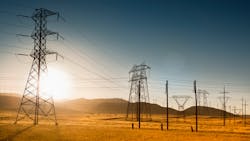California Commission Takes Action to Ensure Summer 2021 Electricity Reliability
The California Public Utilities Commission (CPUC) recently issued a proposal that takes further action to help ensure all electricity resources are used to maintain grid reliability this summer.
The recent proposal, if approved at the CPUC's Feb. 11, 2021, Voting Meeting, would require Pacific Gas and Electric Co., Southern California Edison, and San Diego Gas & Electric to contract for capacity that can be online in time to serve peak and net peak demand this summer. The proposal, officially called a Proposed Decision, is available here.
The proposal is the most recent step in a series of actions the CPUC has taken in an expedited proceeding it opened in response to the rotating outages experienced in August 2020. It is focused on procuring demand-side and supply-side resources needed for the state to maintain electricity reliability for consumers if climate change-driven extreme weather events experienced in the summer and fall of 2020 re-occur in 2021.
Three rulings have been issued in the proceeding thus far, along with the recent proposal. One ruling focused on proposals for expedited procurement of "demand-side" resources such as demand response and critical peak pricing tariffs, as well as a proposal to continue funding for, and modernizing, the Flex Alert program. Two rulings focused on expedited procurement of "supply-side" resources such as obtaining additional megawatts from existing power plants, re-contracting with resources at risk of retirement that are falling off contracts, and/or contracting for any additional battery storage resources from recent solicitations that could be brought online by this summer, culminating with this proposed decision. A subsequent Proposed Decision that will address demand-side measures as well as any additional supply-side measures is expected in March.
"It is my top priority to ensure that we have the demand- and supply-side resources we need to maintain grid reliability," said CPUC President Marybel Batjer. "Because of the near-term need to balance demand and supply this summer, we need all the tools in our toolbox and demand-side resources will play a large and important part in maintaining grid reliability."
In mid-August 2020, the western United States experienced an unprecedented, prolonged heat event, which led to a variety of circumstances that ultimately required the California Independent System Operator (CAISO) to initiate rotating power outages to prevent sustained, widespread service interruptions.
On Oct. 6, 2020, the California Energy Commission, CAISO, and the CPUC issued a preliminary report on the causes of the August rotating outages, which outlined short-term and longer-term actions to mitigate electricity shortages and ensure delivery of clean, reliable, and affordable energy. Among the recommended actions is "expediting the regulatory and procurement processes to develop additional resources that can be online by 2021" and "ensuring that the generation and storage projects that are currently under construction in California are completed by their targeted online dates."
The expedited proceeding the CPUC opened in November 2020 will develop additional demand- and supply-side resources that can be available by 2021.
For more information on the CPUC's reliability efforts, visit here.
